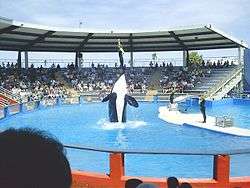Miami Seaquarium
|
The killer whale show at the Seaquarium, starring Lolita. | |
| Date opened | September 24, 1955 [1] |
|---|---|
| Location | Virginia Key, Miami, Florida, USA |
| Coordinates | 25°43′59″N 80°09′56″W / 25.733°N 80.165525°WCoordinates: 25°43′59″N 80°09′56″W / 25.733°N 80.165525°W |
| Land area | 38 acres (15 ha) |
| Annual visitors | 500,000 |
| Memberships | Alliance of Marine Mammal Parks and Aquariums AMMPA |
| Owner | Palace Entertainment[2] |
| Website |
miamiseaquarium |
The Miami Seaquarium is a 38-acre (15 ha) oceanarium located on the island of Virginia Key in Biscayne Bay, Miami-Dade County, Florida, United States and is located near downtown Miami. Founded in 1955, it is one of the oldest oceanariums in the United States. In addition to marine mammals, the Miami Seaquarium houses fish, sharks, sea turtles, birds, reptiles, and manatees. The park offers daily presentations and hosts overnight camps, events for boy scouts, and group programs. Over 500,000 people visit the facility annually. The park has around 225 employees, and its lease payments and taxes make it the third-largest contributor to Miami-Dade County’s revenue.[1]
History
The park was founded by Fred D. Coppock and Captain W.B. Gray and was the second marine-life attraction in Florida. When it opened in 1955, it was the largest marine-life attraction in the world.[1]
From 1963 through 1967, eighty-eight episodes of the 1960s TV show Flipper and two movies starring Flipper were filmed at the Miami Seaquarium. See Ric O'Barry
In 2014 Miami Seaquarium was bought by Palace Entertainment.[3][4]
Lolita the Killer Whale
One of the Miami Seaquarium's attractions is Lolita, the world's oldest captive orca. She is currently the park's only orca. Lolita arrived at the Miami Seaquarium in 1970, where she joined the park's first orca, Hugo. Hugo died in 1980.
On January 24, 2014 the National Marine Fisheries Service proposed amending the Endangered Species Act to remove the exception that did not include Lolita as part of the ESA-listed Southern Resident population of orcas that live in Washington and British Columbia waters. Activists, who proposed such an action to the NMFS in 2013, are hopeful that this might lead to a healthy retirement in a seapen and possibly an eventual release and reuniting with her pod which is believed to include her mother.
Gallery
 Lolita, the Killer Whale.
Lolita, the Killer Whale. The Top Deck dolphin show at the Miami Seaquarium.
The Top Deck dolphin show at the Miami Seaquarium.- Dolphin named Bebe at the Seaquarium in 1969.
Notes
- 1 2 3 "About Us: History". Retrieved February 13, 2013.
- ↑ Wometco Enterprises Bloomberg BusinessWeek
- ↑ "Miami Seaquarium deal is done". The Real Deal. Retrieved January 25, 2015.
- ↑ "List of parks". Palace Entertainment. Retrieved January 25, 2015.
External links
| Wikimedia Commons has media related to Miami Seaquarium. |
